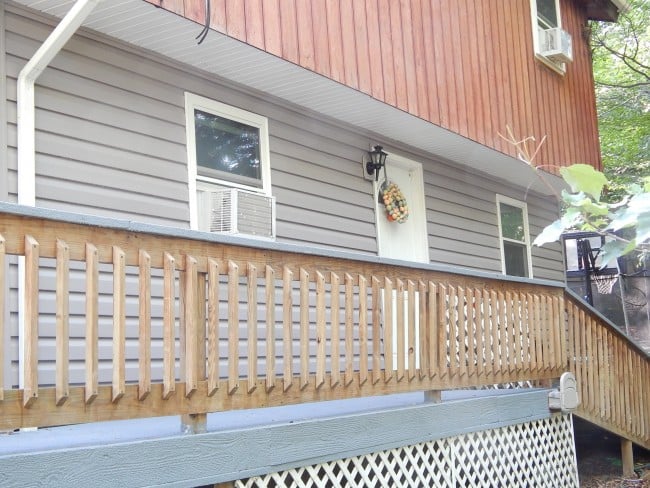
On This Page:
- Getting to Know Your Window Unit Air Conditioner
- Troubleshooting Simple Problems
- Calling a Professional
- Repair or Replace: Asking the Essential Question
- Window Units vs. Central Air Conditioning
Window air conditioners are a fast and affordable way to cool certain rooms in your home. Ideal for renters or people living in mild climates, a window air conditioner uses a minimal amount of energy to maintain optimum comfort levels in your home. As with any appliance, your air conditioner can’t run properly without regular care and maintenance. Get to know your window air conditioner so you’ll understand what’s happening as it runs and why your annual tune-up is so important.
If you detect a problem, begin troubleshooting immediately. Calling in a licensed professional to service your unit when it’s having serious problems will help you save money in the long run by squeezing a few extra years of service out of your appliance.
Getting to Know Your Window Unit Air Conditioner
Before you can troubleshoot or repair your window unit air conditioner, you must understand all the parts that make up this system. Window units feature both interior and exterior parts separated by a center panel.
Interior parts include:
- Front panel or grill: This is the only visible part of the interior half of the window air conditioner. The front panel includes the controls you use to adjust settings on the device as well as the return air grills that pump out cool air. Adjustable louvers in the air grills let you adjust the air’s direction.
- Evaporator coil: Cold refrigerant runs through the evaporator coil. When air passes over the chilled coil, it becomes colder.
- Fan or blower: The fan or blower pulls warm air into the unit, then pushes it past the evaporator coil and through the filter to cool and clean it, respectively.
- Fan motor: Located between the evaporator coil and condenser in a window AC unit, the fan motor enjoys a very compact location. It is fitted to both these components via small shafts. An ac blower motor replacement costs between $100 – $300.
- Thermostat: The thermostat is responsible for measuring and maintaining the temperature inside your unit.
- Filter: The filter is the part of your unit that you will have the most contact with. It’s typically found just inside the front panel, making it easily accessible. You should change or clean the filter regularly.
Exterior parts include:
- Compressor: The compressor pressurizes gas inside the condenser coils. The pressurized gas turns to liquid refrigerant.
- Condenser or condensing coil: The condenser coil releases heat from the refrigerant, allowing it to escape into the surrounding air.
- Condenser fan: The condenser fan blows air over the surface of the condenser coil. This helps release the heat from the refrigerant back into the air.
- Drain pan: Condensate builds up on the cooling coil. This will drip down onto the drain pan.
- Condensate drain tube: Water from the drain pan exits the unit through an exterior condensate drain tube. Not all units have this tube. Instead, some simply have a hole that water can drain through.
A basic understanding of how your window air conditioning unit works will make it easier for you to understand the potential problems you might experience. All air conditioners use refrigerant to cool air, so if you’re familiar with how standard HVAC units operate, then you have a basic understanding of window air conditioners. Window units are simply smaller.
In the compressor, the hot gas is pressurized until it reaches the chilled liquid state. The liquid refrigerant then passes into the evaporator coil. The system’s fan pulls warm air through the filter and into the unit. Here, the air passes over the cold evaporator coil and becomes chilled. The cool air blows back into the room where it mixes with the warmer air in the environment, creating a cooler and more comfortable space.
Ready to start your window air conditioner?
Find ProsTroubleshooting Simple Problems
You can easily fix many common issues with your window unit air conditioner. Troubleshoot the unit for these simple problems before calling in professional help.
Water Dripping From the Unit
It’s alarming to see water dripping off your window unit air conditioner or to find a puddle growing beneath it. Fortunately, this issue isn’t as serious as it seems. A water leak simply means that the pan beneath the unit slopes toward the front of the unit and not the back. Readjust your unit so it slopes backward to instantly correct the problem. When the pan slopes toward the exterior of the home as it should, condensate from the evaporator coil will gather in the pan and drip outside.
Unit Cycling On and Off Frequently
If you feel like you’re constantly hearing your unit cycle on and off, there’s probably a problem with the thermostat or temperature sensor. You might be able to fix this issue yourself. Before calling a professional, adjust your drapes so they don’t obstruct the thermostat or front panel, and clear leaves away from the condenser. If this doesn’t solve the problem, keep reading to learn about problems best serviced by a professional.
Unit Cools Inefficiently
If you’re fighting a constant battle to keep your home cool, there’s probably something preventing your air conditioning unit from operating at peak efficiency. The most common diagnosis – and easiest solution – is a dirty filter.
You should change your window AC filter regularly. Aim to change it at least once every three months and as often as once a month if you have children, pets or a lot of dust in the home. Changing the filter is quick, simple and affordable. Simply open the unit, remove the old filter and replace it with a new one.
AC Unit Won’t Turn On
If your unit won’t turn on, there are a few simple problems you can troubleshoot before calling a professional. First, check to make sure the unit is plugged in. This might seem fairly obvious, but it’s easy to overlook, particularly if the unit plugs into an outlet hidden behind a piece of furniture. If the unit is plugged in, check to make sure you haven’t blown a fuse. If resetting the circuit breaker doesn’t work, it’s time to move on to professional solutions.
When to Hire a Professional Contractor
There are many instances where simple at-home solutions won’t work. It’s important to turn to a professional for all serious problems with your window air conditioner unit. Below are some common problems that a professional contractor can help you with. If you’re experiencing other less common problems with your unit, your contractor can help you diagnose and solve those, as well.
Unit Cycling On and Off Frequently
A unit that cycles on and off too often typically has a problem with the thermostat or temperature sensor. A professional will check the unit to make sure the thermostat sensor is positioned correctly. This might include delicately adjusting the wire and moving the thermostat sensor so it doesn’t touch the evaporator coil.
Your unit might also suffer from a small refrigerant leak. Any standard service visit will catch this problem. Have your contractor tune up the unit and check for anything out-of-place. He might perform a variety of helpful tasks including straightening the fins with a fin comb, charging the refrigerant and repairing leaks.
Blown Fuses From the Window Unit Air Conditioner
If your unit blows fuses or pops the circuit breaker when it turns on, you’re probably running it on an inadequately sized circuit. The typical unit can run off a 15 amp circuit, but larger window air conditioners need a dedicated circuit. Contact an electrician to run a dedicated 20 amp circuit directly to the window air conditioner. This will put an end to blown fuses and eliminate the need to strategically reposition electrical devices throughout the home in an attempt to avoid the problem.
Unit Cools Inefficiently
If changing the filter doesn’t improve your unit’s performance notably, it probably needs a full servicing. Ideally, you will schedule a tune-up with your HVAC contractor once a year before you begin operating your air conditioning unit for the season. During this appointment, your contractor will:
- Check the thermostat to make sure it’s operating correctly
- Inspect the air filter and change it if needed
- Inspect the condensate drain for buildup or blockages and clear as needed
- Check the evaporator coil for dust and dirt buildup and clean when necessary
- Check the evaporator fan and motor for proper function
- Lubricate bearings
- Clear dust and debris from fan
- Adjust fan as needed for proper rotation
- Inspect refrigerant lines for leaks or kinks and repair when necessary
- Inspect and clean the condenser coil
- Check coil fins and straighten as needed
- Lubricate the condenser fan
- Ensure condenser fan has proper rotation and connection
- Check refrigerant levels and charge as needed
Dust and debris will build up naturally inside your air conditioner. A dirty fan or coils will decrease system performance. Low refrigerant levels might also be to blame. A simple tune-up will address all these issues and might even alert you to problems you weren’t aware of. It’s important to work with a reliable contractor and schedule this visit yearly.
AC Unit Won’t Turn On
If your unit fails to turn on while it’s plugged into a working outlet, the problem is likely in the power cord. A professional can test the power cord using a volt-ohm-milliammeter (VOM) to RX1 scale attached to the prongs. If the power cord is indeed the problem, your AC contractor can replace this part entirely, instantly restoring your system to proper operation.
Ready to start your window air conditioner?
Find ProsRepair or Replace: Asking the Essential Question
There comes a time in the life of any appliance where you must decide whether it’s more cost-effective to continue repairing the unit or to invest in a replacement. The average cost to repair a window air conditioner is $213, but this can vary from just $50 for minor repairs to $700 for major problems. The first thing you can do when you’re considering the value of a repair is to compare your contractor’s estimate with the cost of a new unit.
Window air conditioner units can vary in price from less than $150 to more than $500 per unit to purchase. Here are some examples of window AC units and what they cost.
| Brand | BTU | Features | Price per Unit |
| GE | 5,100 | 2 speeds | $129 |
| LG Electronics | 5,000 | ENERGY STAR 2 speeds |
$139 |
| GE | 6,050 | Remote control 2 speeds Programmable timer |
$179 |
| LG Electronics | 8,000 | Remote control 3 speeds Programmable timer |
$239 |
| GE | 8,100 | Remote control 3 speeds Programmable timer |
$239 |
| Frigidaire | 10,000 | 3 speeds Programmable timer |
$249 |
| Haier | 12,000 | Remote control 4 modes, incl. Energy Saver 3 speeds Programmable timer |
$299 |
| Sharp | 12,000 | Remote control 3 speeds Programmable timer |
$329 |
| LG Electronics | 12,000 | Remote control 3 speeds Programmable timer |
$349 |
| GE | 14,250 | Remote control 3 speeds Programmable timer |
$399 |
| Danby | 15,000 | ENERGY STAR Remote control 3 speeds |
$449 |
| LG Electronics | 18,000 | Remote control 3 speeds Programmable timer |
$499 |
| GE | 18,250 | Remote control 3 speeds Programmable timer |
$499 |
| Frigidaire | 12,000 | Remote control 3 speeds Programmable timer |
$629 |
| LG Electronics | 18,000 | Remote control 2 speeds Programmable timer |
$699 |
British thermal units, or BTUs, are the deciding factors that will help you choose the best appliance for your needs. If you’ve been struggling to adequately cool your home, consider your current unit’s BTU before investing in extensive repairs. Even the best maintained unit can’t combat full sunlight, kitchen heat, or a large room if it lacks the proper BTU. Check this chart to see if your unit is the proper size. If not, it’s time for a replacement.
| Square Feet | Recommended BTU | Full Sun BTU | Kitchen BTU |
| 800 | 15,000 | 16,500 | 19,000 |
| 550 | 12,000 | 13,200 | 16,000 |
| 450 | 10,000 | 11,000 | 14,000 |
| 340 | 8,000 | 8,800 | 12,000 |
| 280 | 7,000 | 7,700 | 11,000 |
| 260 | 6,000 | 6,600 | 10,000 |
| 150 | 5,000 | 5,500 | 9,000 |
If a room regularly has more than two people in it, you’ll want more than the recommended BTU. Add 600 BTUs per person to maintain adequate home comfort.
Your appliance’s age also plays an important role in your decision to either repair or replace the unit. Most AC units have a lifespan of about 10 years. If you’re diligent about your annual maintenance, filter changes and safe storage of the unit when it’s not in use, you might add a few years to the lifespan. If your air conditioner is older than 10 years, you’re probably better served buying a replacement than investing in more repairs. Today’s newer systems offer energy-efficient benefits that can reduce your energy expenses, helping you recoup some of the initial cost of the investment.
Window Units vs. Central Air Conditioning
If you’ve decided that it’s time to invest in a new air conditioner, you have one final decision to make. Do you want to stick with a window air conditioning unit or upgrade to a central air conditioning system? There are drawbacks and benefits on both sides of the argument.
Benefits of Window Air Conditioning Units
- Easy installation – Plugs into a standard outlet with no additional wiring
- Affordable
- Designed for one room at a time – Ideal for climates where you don’t need to cool the entire home
Drawbacks of Window Air Conditioning Units
- Inefficient at managing high humidity levels
- Difficult to properly seal in the window, so air might escape
- Low efficiency with typical energy efficiency ratings (EER) of 10 or 11
Benefits of Central Air Conditioning
- Cools the entire home
- Manages humidity effectively
- High efficiency with typical EER ratings of 14 or 15
Drawbacks of Central Air Conditioning
- New units are expensive
- Installing a new central air conditioning system is complex and time-consuming
- Might provide unnecessary cooling to unused rooms
If you live in a relatively cool climate and only need air conditioning for a few rooms in your home, window units are an efficient answer. By turning these air conditioners on and off when using the rooms, you’ll avoid the cost of cooling your entire home when you spend the day in only a fraction of the house.
If you live in a hot and humid climate, however, you will probably find that you’re better served by central air conditioning. This is a significant expense and something you’ll probably need to save up for. Installing central air conditioning typically costs between $3,681 and $7,173, and repairs to upkeep the unit typically run homeowners between $150 to $500.
Share your experiences with fixing a window air conditioner in the comments!
 Carpet Buying Guide
Carpet Buying Guide  The Truth About DIY Roofing
The Truth About DIY Roofing  How to Find and Hire a Maid Service: Questions to Ask, Tips and More
How to Find and Hire a Maid Service: Questions to Ask, Tips and More  Spring Cleaning Checklist
Spring Cleaning Checklist  How to Regularly Clean Your Upholstery, From Random Spills to Pet Hair
How to Regularly Clean Your Upholstery, From Random Spills to Pet Hair 

This is some great information, and I appreciate your suggestion to call a professional if resetting the circuit breaker doesn’t help turn your AC on. My air conditioner wouldn’t turn on yesterday, and I tried resetting the circuit breaker, but it didn’t solve the issue. I’ll definitely look into having a professional come and take a look to see what the problem is. Thanks for the great post!
Trying to figure out why my a/c will not change temperatures it beeps when I press the button but all it shows on the screen is AS or 85
AS in my manual means a Room temperature sensor error.
My Frigidaire AC unit’s themperature setting will not lower or raise temperatures. It is stuck on 85 or AS and the remote does not change it nor does it change manually.
We have a wall unit and find in the heat cycle a problem with the fan coming on first and cool air blowing and after heat discontinues the fan continues and blows cool air. We have fan setting on low and heat at 70. Any suggestions?
The heat does not come on even though it is set for heat and 76 degrees. I have reset but that did not solve the problem. It worked earlier in the season.
When I turn my window unit off it won’t shut off completely . I still hear something running in the unit. The only way I can make it shut off is to push the button on the plug. I also have to do the same to turn back on.
Hello:
I have an Amana heating and cooling window unit. The heating works fine, and I can’t get the cooling portion to work, and the compressor will not kick-in when set to cooling. The fan works, but I can tell that the compressor is not coming on. The unit is approx. 7 to 8 years old, and I suspect that it is something minor wrong with the unit, because the heating phase works just fine. Any suggestions where I can troubleshoot this unit. A switch, thermostat, etc. My studio is only 12 x16, so a low rated BTU replacement would not be too expensive, but I don’t want to incur any large repair bills.
Your suggestions will be appreciated. R. J. Gould
Lg air conditioner will not change speeds
Facts…if a compressor wont come on there are several things could be at fault.
A. no power coming into the unit.
B. Thermostat/thermistor not telling compressor to start.
C. Loose wiring
D. Pressure switch or temperature controller faulty. (If equipped)
E. Not enough gas pressure in lo-side circuit to overcome the low pressure switch (if equipped.)
F. Too much gas in circuit allowing hi- pressure swith to activate ( if equipped)
G. Compressor burned out…….
If youre window unit powers up but compressor wont come on the first thing u wanna do is look for the obvious i.e. wires burned, wires cut, freon line busted….but dont be digging around in there if yur a novice because if yur hand finds the terminls on the capacitor youll know it. Shut the unit off and unplug it for a few secs the plug back in and look at digital readout it could show a code for you the most common being A5 or faulty thermistor. The thermistor can be bench tested. Heres how …remove the thermistor from the evap and carefully unplug it from the printed circuit and while yur doin that also visually inspect the printed cards or motherboad…Next notice any markings or data on the wires…possibly a temperature value and a ” k” number like 10k or 20k whatever. The important info u need to know is really two things….the k number and which one of two types the thermistor is, either PTC or NTC. meaning either positive or negative temperature coefficient which in turn means as the temp rises in a PTC the resistance drops and exactly opposite on the other. Test this 2 ways…first and again notice the k number if its lets say 30k then u should be able to check yur resistance between the 2 wires and get somewhere close to that 30k if not… it doesnt necessarily mean its a bad thermistor just might b lazy but if it shows no continuity at all then chunk it …its no good. If it does show a comparable resistance value with its k number, then you can check its functionality by applying heat to the thermistor tab while yur probes are still attached and you should either see a rise or fall in the resistance value and dont go runnin to bubbas lookin for an old beat up window unit to get a beat up thermistor off of it lmao but seriously if bubba does have one its critical that the markings on bubbas are the same as yours because if not it can really screw a unit up mixing thermistors…the thermistor gives a signal to compressor but first its goes thru a printed cicuit with tiny wiring and soldering that could be affected or melted if the conductors are too big in bubbas thermistor by way of pulling or drawing more amperage or residual current although its not energised per sey in its design. A thermistor dont do much at all matter of fact…it just creates a “reference” point, number or temperature for the lil ecm or computer module or whatever so it can produce algorythms in order to know when to shut off compressor…(note..some units have 2 sensors….one which is as far away from the evap and condensor as it can be that is called the ambient temp thermistor/sensor which tells the other components the surrounding temp in the room so they can also create a reference point to also aid in the math they do
Brand new Frigidaire window unit works fine in cool but I set it on heat the unit comes on but just cool not hot air comes out I have trouble shot it as far as I can it’s freezing in my kitchen where it is set up please help 77 years old living alone
I have a 18,000 btu window heat and cool unit. It cools fine but heat doesn’t work although the fan blows. Please help
I have a window air conditioner and the fan won’t turn off after it reaches the set temperature. I have it set for auto.
What does it mean when plug my AC in it will beep n i see CC but ut wont turn on n run?
We have a large, Haier multifunctuonal window AC unit.
We noticed last summer and, now, already, this summer that, instead of picking up on the inside temperature to cool the room, the thermostat is picking up on the outside temperature.
So, it could be 76 degrees in my living room, as it is right now.
The thermostat could be set at 72, as it is currently.
However, the AC has not kicked on because it is now 63 degrees outside.
If I go over and lower the thermostat setting to 62 or 63, the AC kicks on to cool the living room.
The AC unit is going on 6 years old.
We did notice issues when we first got it but, it is such a problem to get it in and out of the window (which is the only way the Store would honor the warranty, at that time) that my husband did not feel that the original issues warranted the extra work.
Now, we have this major issue which, really affects the health of certain members of our household.
Is there anything I can do (I am fairly handy with repairs, installations, etc, with the correct information avail) or, are we just out of luck with this AC?
Thank you!
My air conditioning unit blows cold seems like fan don’t change speeds and unit is louder than other units
My Frigidaire LRA087AT7 window air conditioner won’t turn on. Every once in a while it beeps. I suspect it may be because when I was looking to turn off an outlet in another room, and I was guessing which circuit breaker to switch off, I quickly turned off/on the window AC unit’s circuit breaker. Any ideas?
My unit blows great it doesn’t shut on and off it runs fine I think. But the temp it reads continues to rise and doesn’t go down. Thats the confusion. Because it never blows warm air. I make sure it has good ventilation. So what and how do I check it to make sure it’s not over heating. Its a wind chacer portable unit
My Frigidaire window AC will not blow cold air but compressor turns on/off and coils are clean what do I do
I have a small window unit and I unplugged it earlier and when I plugged it back it every once in awhile it has a noise like idk maybe a fan sounding dry or hitting something what did I do?
Hi. My window ac kicks off constantly during peak hot hours of the day and blows hot air out until it kicks back on. But at night when it has significantly cooled off it runs and never shuts off. Its like the thermostat is backwards. Please any help or suggestions is very much appreciated.
My window unit is leaking on inside of home instead of outside and it has damaged some drywall. How do i fix this???
Question: Does the outer compartment of a window unit air conditioner serve any function other than to hold the air conditioner in place in order to install it in a window?
I have a 15000 but window unit and its been working fine but it has started turning on and off by itself what would cause it to do this. help me please
Terry September 6, 2018
I have a question. I was given a GE 5,000 btu window top vent AC last year. It’s a not a new model, maybe 4 or 5 years old.
It’s been well taken care of and properly stored. Here in New England, AC’s are usually used 4 months out of the year. The vent is at the top vs. the front.
But wow, this AC was working great! Out of 4 window AC’s, this lil GE blasts cold better than the two 5,000 btu year old AC’s purchased last July, & the brand new 6,000 btu, purchased this July.
Last summer the GE was housed in a small bedroom, and put into a window that has all day shade.
The shade is provided by a very old, large Maple that towers over most of west side of the house.
It was actually so cold in the room last summer, we would leave the door open to cool the tiny back hall and entryway (@ 1/4) of the kitchen!
If the unit was on AC, it usually blew so artic, it would often produce ice on the back side (outside). We’d keep the GE off only turning the unit on during the peak hours of heat, (2-5pm. 9pm-Midnight), to cool the room/areas comfortably.
I just put the GE in a few weeks ago. The same small bedroom but this time a south facing sunny window, that receives direct sun for 2 hours a day (12-2pm). I thought this would be a better placement for ice buildup. It turned out to be a good choice. AC icing was not an issue.
The GE was working great! Now placed at the long end of the room, it seemed to still cool efficiently room, hall & entry to kitchen.
Then the other day though the GE was definitely running, it was hot in the room. The AC did sound a bit “different” but I couldn’t explain just how…
The best way I can describe how this GE usually sounds is,
It sounds like something, a motor or compressor is kicking in intermittently. It stays on for a while than stops. All the while, cold air is being powerfully projected/blown out of the top vent of the AC. But even when the motor/ compressor or whatever is intermittently off, there’s still a quieter humming & the swishing sound of cold air being projected/blowing out?..
The GE didn’t sound like it was shutting down intermittently. Then it appeared that the fan wasn’t moving on the low/high speed. I nudged the fan manually, it started to spin & stayed spinning on its own.
Some air was blowing out & it was cold but it wasn’t projecting/blowing out w at the same pressure/velocity. It was a lighter, less powerful flow of cool air. Not enough to cool the room.
I’ve taken the cover off and it’s definitely making cool air. All the piping & grills show that this part is working quite well.
Even tho the fan spins w a bit of help to start off, the cold air is barely coming thru the top vent to AC the room. All the wire/connections seem fine. Any suggestions?
I mistakenly kicked the lcdi unit’s either reset or test button, my a/c wall unit tured off and i have no idea what to do. I live in South Florida. It is really an emergency for me. Thank you.
My LG Wall mount AC is acting strangely.When set on energy saver it will trip the surge protector it’s plugged into after a few minutes.Also,when I turn it off at the control panel it won’t completely power down and eventually THAT will trip the surge protector.When set on cool it works fine,that is until I try and shut it off
what should be the temperature of the air coming out of a 12,000 btu window ac 110volt
After pressing the reset button, the compressor comes on for about 30 seconds, but then it shuts down. I have only had it for 6 months. What is the problem?